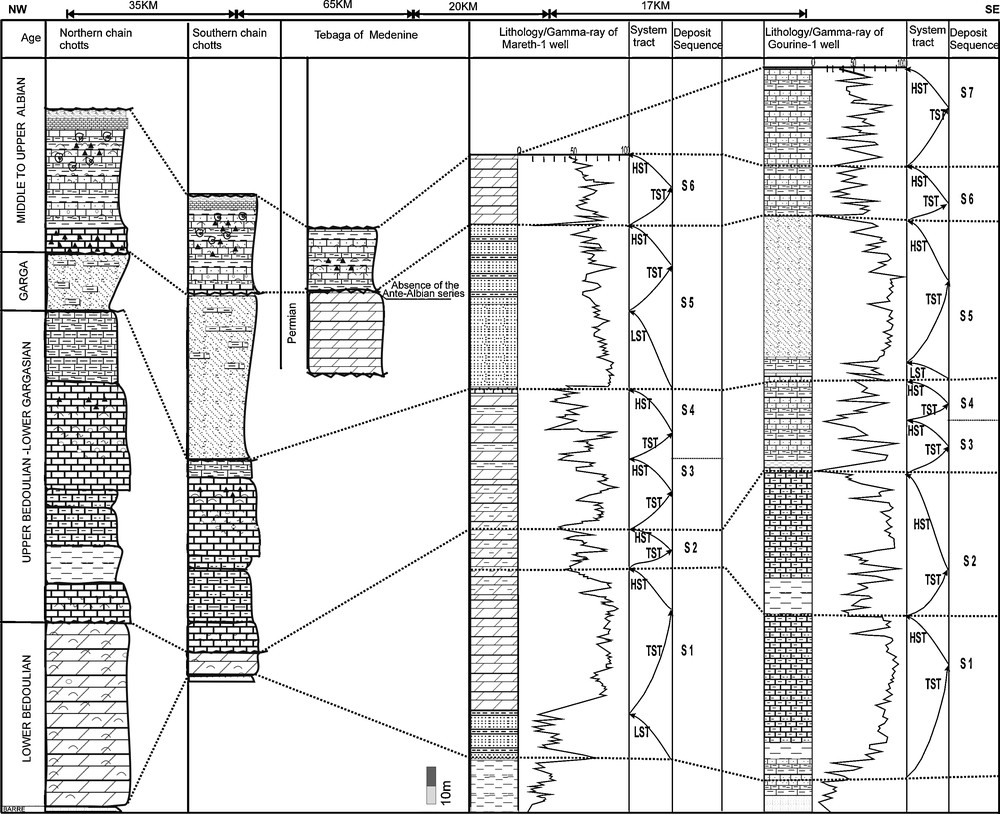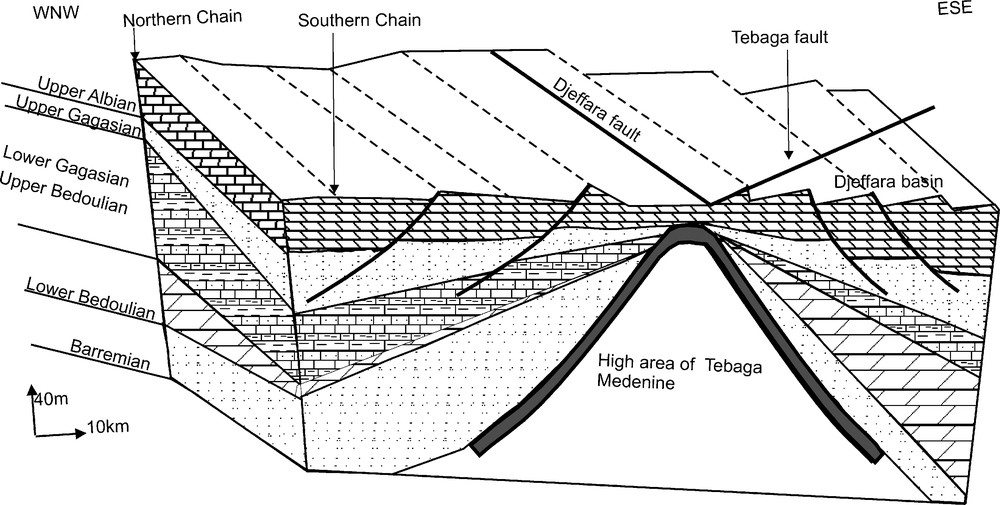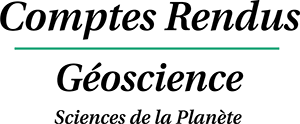1 Introduction
Tunisia is located in the eastern edge of North Africa, between the Mediterranean Sea, Algeria and Libya (Fig. 1A and B). The study area belongs to the western Palaeotethys margin of the North African plate; it is a transition zone between the Djeffara fields to the south and the Atlasic belt to the north. It corresponds to a folded structure inherited from the NW–SE compressional phase [3,4,6,14,20,28,30,32]. The Chotts basin is characterized by a mixed sedimentation, which is distinguished by the evolution of their sedimentary infilling. Sedimentary unconformities were identified; the most important ones are recorded between Aptian and Albian deposits [13,15,16,18]. They are related to major tectonic phase recorded in the Tunisian Atlas [23,24,26,27] and the North–South Axis [1,9,19,21]. Differently from the northern one, the study area is characterized by a dominance of continental sedimentation that provides few arguments for a precise and reliable dating, so that no correlation was proposed between the Chotts chains and the Djeffara area. The major aims of this paper are to make a tentative comparison between marine and continental deposits, to identify the deposit sequence by the sedimentological, biostratigraphic and well-logging signals’ data, and to characterize the relationship between the sedimentary and regional tectonic events at the Austrian stage.

(A) Geographic and geologic situation of Tunisia in the Maghrebian domain. (B) Geologic and tectonic map, showing the main outcrop tectonic lineaments in southern Tunisia [7].
(A) Emplacement géographique et géologique de la Tunisie dans son contexte maghrébin. (B) Carte géologique et tectonique du Sud tunisien, montrant les principaux accidents tectoniques identifiés en affleurement[7].
2 Geologic study
The Chotts area occupies an intermediate position between two tectonic domains distinguished by their deformation style [12,20,30] (Fig. 1A and B). The southern Atlas is characterized by major structural features, which controlled the distribution of Mesozoic and Cenozoic deposits. It is corresponded to the east-west isolated anticlines in the southern Gafsa basin (Séhib, Berda, Orbata) and these of the Chotts ranges (Sif Lham, Bir Om Ali, Hadifa, Radouane, Foum El Hassane, Foum El Argoub).
The northwest–southeast Gafsa and Negrine Tozeur strike-slip systems correspond to ancient faults that controlled the Mesozoic palaeogeographic evolution [2,16,29,31]. These transverse faults offset the sedimentary deposits and constitute a tectonic pinch where the Atlasic fold bundles are extended, with the other right one en echelon. The east–west Chotts features represent the most southern structures of the Atlasic domain [4,6,29,31,32].
3 Sedimentary units
The sedimentological and biostratigraphic study of the Sif Lham section allow us to identify four sedimentary units outlined by erosive surfaces, showing control of the sea level's changes and contemporaneous tectonic activities (Fig. 2 and 3). The dolomitic bar, which forms the bulk, is a common feature all over the area. The presence of Orbitolines, Rudists, Foraminifera associations (miliolids, pseudotriloculinids), algae and oncolites suggests an infralittoral deposit. This Barremian to Bedoulian dolomitic bar is outlined at the top by a hard ferruginized surface that characterized a slowing down of the sedimentation rate. The top of this unit is marked by a secondary dolomitization indicating a tidal flat environment (Fig. 3E and F). The second sequence of the Orbata Formation is composed by a succession of carbonates, clay and marls. The fauna is abundant, yielding Gastropods, Orbitolinids, bivalves and Echinoderms that inferred a marine platform environment. The top of this sequence reveals sandy limestones, with poor fauna and clay. The third sequence is characterized by fine-grained sands, with silicified wood fossils attributed to deltaic deposits. At the top, limestone, beds mark the sandy level. The petrographic study of the limestone beds shows shell-rich micrites and especially orbitolinids (Mesorbitolina texana), indicating a Late Gagasian age. Molluscan coquina limestones, marls, clays and dolomites characterized the fourth sequence. The limestone contains gastropods, bivalves, Foraminifera (orbitolinids) and ammonites (Knemiceras) [5,8,10,11,17] characterizing marine environment deposits during the Upper Albian. The end-Albian deposits are indicated by evaporites and marls.

Aptian and Albian lithostratigraphic section and sedimentary deposits units of the Sif Laham outcrop.
Coupe lithostratigraphique et unités des dépôts sédimentaires de l’Aptien et de l’Albien en affleurement de Sif Laham.

Aptian and Albian microfacies study in the Chotts area, showing faunistic diversity and deposit environment evolution. (A) Biomicrite and biosparite oolitic with echinoderms; (B) Biomicrite and biosparite with abundant and diversified microfauna. (C) Biomicrosparite and biosparite with orbitolins and echinoderms. (D) Biosparite with ostracods and bioclasts. (E) Microsparite with early dissolution and secondary dolomitization. (F) Biosparite with ferruginous elements and dolomite.
Étude des microfaciès de la série Apto-Albien dans la zone des Chotts, montrant la diversité faunistique et l’évolution du milieu de dépôt. (A) Biomicrite à biosparite oolitique à débris grossiers d’échinodermes. (B) Biomicrite et biosparite à microfaune abondante et diversifiée. (C) Biomicrosparite à biosparite à orbitolines et échinodermes. (D) Biosparite à ostracodes et à bioclastes. (E) Microsparite à dissolution précoce de coquille et dolomitisation secondaire. (F) Biosparite à éléments ferrugineux, avec des dolomies.
4 Well-logging sequence stratigraphy
The study of radioactive logging signals of the Orbata Formation between the Mareth and Gourine wells allows us to characterize five deposit sequences, each one represented by a transgressive and highstand system tract. The lowstand system tract is rarely identified; it limits the fourth sequence (Fig. 4) by sandy limestone facies. The top, a positive radioactive logging gradient, indicates the beginning of a transgressive period.The first system tract begins with a transgressive interval represented by shaly dolomitic limestones. This interval is composed by parasequences marked by a positive radioactive logging gradient related to an increase in the argillaceous fraction. The parasequence-containing fining-up indicates the retrogradation of deposits towards the top (deepening-upwards parasequence).

Lithostratigraphic column and sequential subdivision from the well-logging signals of the Aptian and Albian deposits of the Gourine 1 well (GRN-1).
Log lithostratigraphique et découpage séquentiel à partir des enregistrements diagraphiques des dépôts de l’Aptien et de l’Albien au puits Gourine 1 (GRN-1).
The maximum of gamma-ray recording is directly correlated with deepening episodes corresponding to the maximum flooding surface (mfs). The highstand system tract, which is represented by marls at the base and limestones bioclastic oolitic at the top is represented by elementary parasequences showing negative shallowing-upwards gradient. It testifies to the aggradations and the tendency to the emergence of a depositional environment towards the top of each parasequence. It is represented by shaly limestone alternations of the platform prograding environment, related to the time when the sea level had decreased, marked by the available space at the top of the highstand system tract. The Foum El Argoub detritic series is capped by a major cartographic unconformity and defined by a sedimentary hiatus characterized by the absence of the Upper Aptian (Clansayesian) and Lower to Middle Albian deposits. This hiatus is signed by a significant gamma-ray reduction (Fig. 4 and 5).

Aptian and Albian lithostratigraphy and sequence correlation through the Chotts outcrops and the Djeffara wells.
Corrélation lithostratigraphique et séquentielle des dépôts de l’Aptien et de l’Albien entre les affleurements des Chotts et les forages de Djeffara.
The Zebbag Formation is subdivided into two depositional sequences recognized in the Gourine 1 well (Fig. 4). Only one sequence was identified in the Mareth 1 well (Fig. 5). Albian deposits started with a positive radioactive gradient, indicating retrogradation during deepening-upwards, related to the transgressive episode. The following series are represented by coarsening-up parasequences, indicating a shallowing-upwards.
5 Stratigraphic changes and palaeogeographic implications
Aptian and Upper Albian deposits were drilled by several petroleum wells. In this work, we have consulted the Gourine 1 and Mareth 1 petroleum wells, which contain lithostratigraphic and well-logging information. Fig. 5 illustrates a tentative correlation based on gamma ray, sedimentologic and biostratigraphic data recovered from the two areas. The Aptian corresponds to five deposit sequences, identified in two of the studied wells and are equivalent to the three sedimentary units identified in the Chotts area. The first two deposit sequences (S1 and S2) correspond to the lower part of the Orbata Formation. However, the two sequences (S3 and S4) correspond to the second unit of the Orbata Formation in the Chotts area. The following fifth deposit sequence represents the Foum El Argoub continental deposits and is limited by a sedimentary unconformity. The latter indicates a tectonic uplift and corresponds to the Upper Aptian-Lower Albian hiatus. The Upper Albian unit corresponds to the lower part of the Zebbag Formation. The latter is identified in the Chotts area and corresponds to the deposit sequence S6 in the MAR-1 well. However, in the GRN-1 well, it is represented by two deposit sequences, S6 and S7. Analysis of the Aptian and Upper Albian deposit sequences between the Chotts and the Djeffara areas shows a progressive thickening towards the southeast. Sedimentation lap-out is also controlled by sea-level changes and by tectonics activities during these intervals. The third-order sequences and the associated recognized unconformities can be compared with the eustatic sedimentary sequences (Fig. 5).
The Bedoulian dolomitic series contains Orbitolins and Rudists, suggesting a medium infralittoral environment. It extends on all the area, their thickness is 40 m in the Sif Laham outcrop and is reduced towards the southern chain of the Chotts (1 to 2 m in the Foum El Argoub outcrop) (Fig. 5). These characteristics explain that during the Bedoulian, the southern chain of the Chotts is also invaded by less deep sea compared to the northern chain of the Chotts. However, the sandy levels of the Foum El Argoub Formation are reduced in the northern part and thicken in the southern part of the chains, where approximately 60 m of coarsening fluviatile sandstone are observed. The Tebaga Medenine outcrop is limited by the Zemlet El Ghar and Tebaga faults, which have near-east–west trends [14,22,25]. The section of the Tebaga Medenine area reveals an Upper Albian facies that has been identified as directly deposited on the dolomitic Permian with fusiline fossils. This high structure seems to correspond to a regular anticline covered by the Upper Albian series (Figs. 5 and 6). This uplift block, emerged until the end of the Lower Cretaceous, seems to be at the origin of detrital lap-out during the Lower Cretaceous, where the sandy fraction is mostly recognised in the Chotts and Djeffara basins. The thicknesses of the studied series show a tilted block structured with thickenings towards the northwest and the southeast on both sides of the Tebaga Medenine high area. This uplift, limited by the NW–SE Djeffara flexure, represents a palaeogeographic limit in southern Tunisia. Thus, the thickness variations suggest a differentiation into distinct fields guided by a rising of the Tebaga Medenine area and accentuated by tectonic deformations (Fig. 6).

Aptian and Albian diagram block showing the impact of the tectonic deformations and of the upheaval of the Tebaga Medenine mole on the palaeogeographic evolution of southeastern Tunisia during the Aptian-Albian.
Bloc diagramme illustrant l’impact des déformations tectoniques et du soulèvement du môle de Tébaga de Médenine sur l’évolution paléogéographique de Sud-Est tunisien au cours de l’Aptien–Albien.
6 Sea-level fluctuation and structural significance
Southern Tunisia belongs to the western Palaeotethys margin, which is composed of the Chotts and Djeffara basins and is characterized by abnormal contacts. The sedimentologic study of Mid-Cretaceous series in the Chotts and Djeffara areas allows us to define four sedimentary units outlined by sedimentary unconformities. Sequence stratigraphy analysis of the Aptian and Upper Albian series leads us to consider several deposit sequences controlled by structuring and sea-level changes. Their facies and thickness variations from outcrop and well data are interpreted as being related to the inherited differential subsidence, revealing a regressive-transgressive general tendency.
The Djeffara basin is separated from the Chotts region by the high of Tebaga de Medenine, bordered by the extensive N120 Djeffara fault and characterized by the outcropping of the Permian facies in triple junction with the Jurassic and the Cretaceous.
The Upper Aptian to Lower Albian regressive period resulted in the installation of a continental sedimentation, which indicates the continuation of erosion on the African continent [24], as a consequence of the extensive movement of Africa relatively to South America and their strike-slip rotation with the Eurasiatic plate at the Austrian stage. These movements are signed by the formation of high topographically areas in southern Tunisia, playing the role of a local continental source infilling the relatively subsiding Chotts and Djeffara zones.
The Upper Aptian and Lower to Middle Albian generalized regression, recognized in the southern Palaeotethys margins, were followed by the Vraconian and the Cenomanian large transgressions. This sea-level change, the exhumation of the Tebaga de Medenine area, the associated unconformities, the salt tectonic movement in the chain of the Chotts, and the subsidence of the Chotts and Djeffara basins and other triple junctions in southern Tunisia could be related to the global plate movements.
7 Conclusion
Sequence stratigraphy analysis of the Aptian and Upper Albian deposits yields four sedimentary units outlined by erosive surfaces. The latter recorded the sea-level changes during the Mid-Cretaceous. Their facies and thickness variations from outcrop and well data are interpreted to be related to the inherited differential subsidence. The sequential study allows highlighting the variation in number and thickness of Aptian and Albian deposit sequences. These changes are the result of the platform retrogradation, followed by infilling and progradation episodes.
The outcrop and subsurface integrated study shows that regressive cyclically detrital inputs and transgressive pulses characterize the Chotts area and the Djeffara basin during Aptian-Albian times. These facies were deposited in two differential subsidence areas separated by the Tebaga de Medenine high area. Southern Tunisia was controlled by sea-level changes, geodynamic evolution and differential subsidence, associated with distensive structuring in relation with the extensive movement of the African plate relatively to South America and their strike-slip rotation with Eurasia during the Austrian phase.


